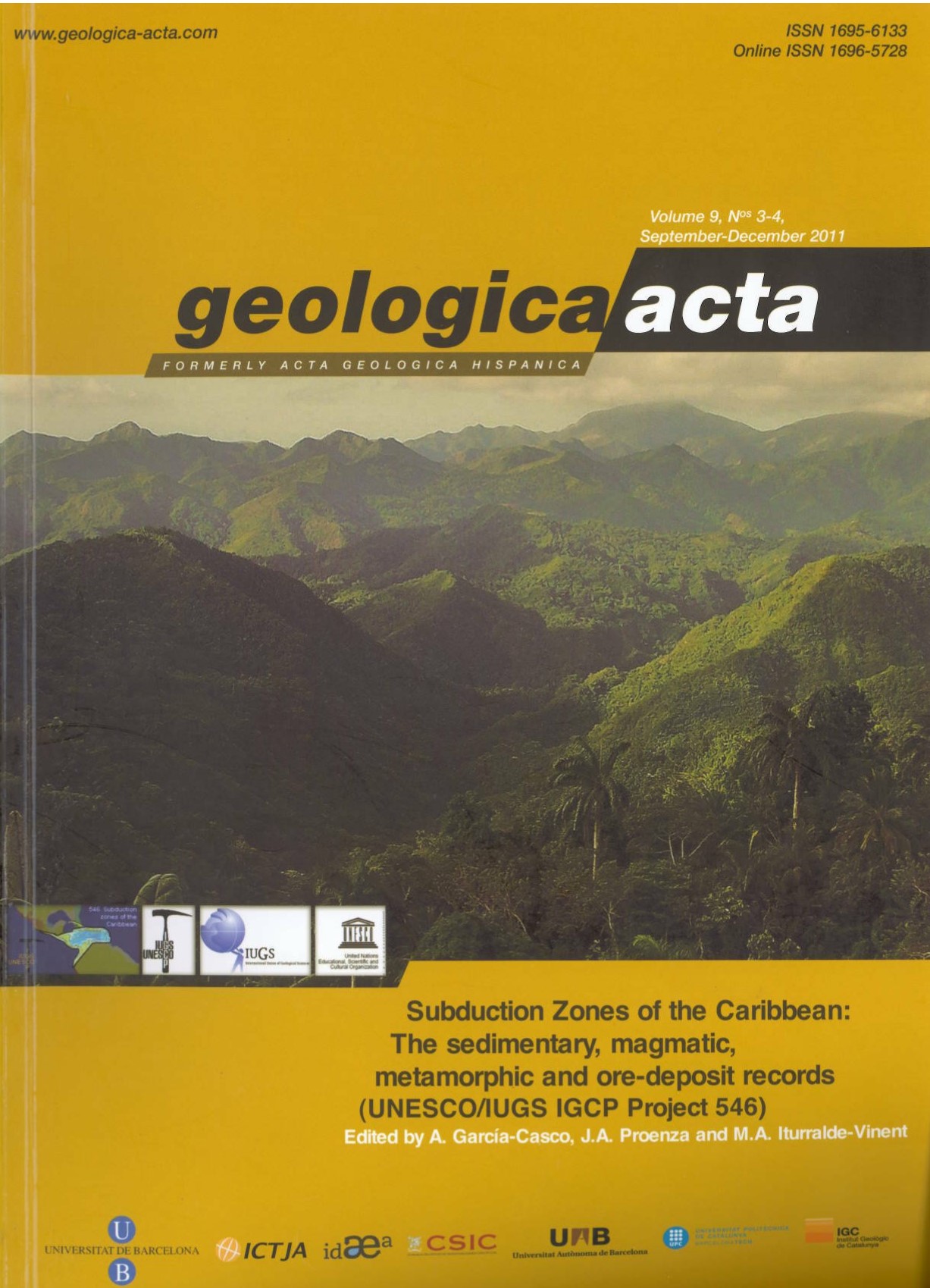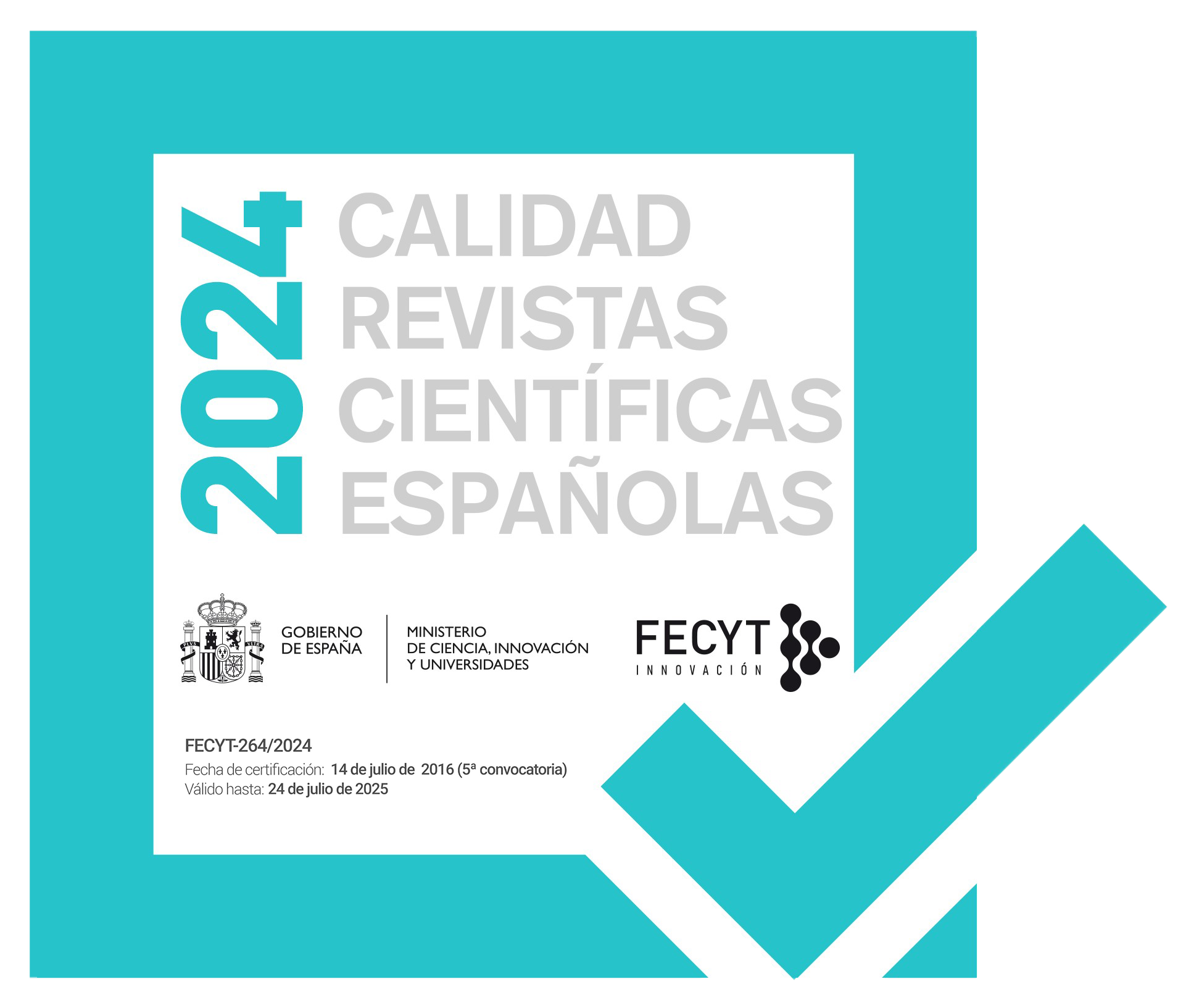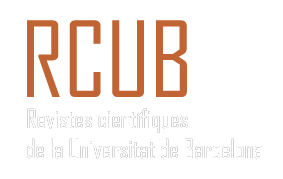Serpentinites and serpentinites within a fossil subduction channel: La Corea mélange, eastern Cuba
DOI:
https://doi.org/10.1344/105.000001662Keywords:
Serpentinite, Subduction Channel, La Corea Mélange, Cuba, CaribbeanAbstract
A variety of metaultramafic (serpentinite) rocks in La Corea mélange, Sierra de Cristal, eastern Cuba, show differences in chemical, textural and mineralogical characteristics demonstrating a variety of protoliths. The mélange originated during the Cretaceous as part of the subduction channel associated with the Caribbean island arc. This mélange contains high pressure blocks in a serpentinite matrix and occurs at the base of the large tabular Mayarí-Cristal ophiolite. Two principal groups of serpentinites have been identified in the mélange: a) antigorite serpentinite, mainly composed of antigorite and b) antigorite-lizardite serpentinite, composed of mixtures of antigorite and lizardite and bearing distinctive porphyroblasts of diopsidic clinopyroxene. Antigorite serpentinites are closely related to tectonic blocks of amphibolite (representing subducted MORB) and constitute deep fragments of the serpentinitic subduction channel formed during hydration of the mantle wedge. The composition of the antigorite-lizardite serpentinites and the presence of clinopyroxene porphyroblasts in this type of rock suggest that abyssal lherzolite protoliths transformed into serpentinite before and during incorporation (as tectonic blocks) in the shallow part of the subduction channel. Although the studied rocks have different origin, mineralogical compositions and textures, they display similar PGE compositions, suggesting that these elements experienced no significant redistribution during metamorphism. Both types of serpentinites were exposed together in the La Corea mélange during the Late Cretaceous, during obduction of the overriding Mayarí-Baracoa ophiolitic belt that led to exhumation of the subduction channel (mélange)References
Abu El Ela, F.F., Farahat, E.S., 2009. Neoproterozoic podiform chromitites in serpentinites of the Abu Meriewa–Hagar Dungash district, Eastern Desert, Egypt: Geotectonic implications and metamorphism. Island Arc, 19(1), 151-164. doi: 10.1111/j.1440-1738.2009.00689.x.
Adamovich, A., Chejovich, V., 1964. Principales características de la geología y de los minerales útiles de la región nordeste
de la Provincia de Oriente. Revista Tecnológica, 2, 14-20.
Agranier, A., Lee, C.-T.A., Li, Z.-X.A., Leeman, W.P., 2007. Fluid-mobile element budgets in serpentinized oceanic lithospheric mantle: insights from B, As, Li, Pb, PGEs and Os isotopes in the Feather River Ophiolite, California. Chemical Geology, 245, 230-241.
Angeli, N., Fleet, M.E., Thibault, Y., Candia, M.A.F., 2001. Metamorphism and PGE-Au content of chromitite from the Ipanema mafic/ultramafic Complex, Minas Gerais, Brazil. Mineralogy and Petrology, 71, 173-194.
Arai, S., 1992. Chemistry of chromian spinel in volcanic rocks as a potential guide to magma chemistry. Mineralogical Magazine, 56, 173-784.
Bailey, S.W., 1980. Summary of recommendations of AIPEA nomenclature committee. Clay Minerals, 15, 85-93.
Batanova, V.G., Sobolev, A.V., 2000. Compositional heterogeneity in subduction-related mantle peridotites, Troodos massif,
Cyprus. Geology, 28, 55-58.
Becker, H., Horan, M.F., Walker, R.J., Gao, S., Lorand, J.P., Rudnick, R.L., 2006. Highly siderophile element compositions of the Earth’s primitive mantle. Geochimica et Cosmochimica Acta, 70, 4528-4550.
Blanco-Quintero, I., García-Casco, A., Rojas Agramonte, Y., Rodríguez Vega, A., Lázaro, C., Iturralde-Vinent, M.A., 2010. Metamorphic evolution of subducted hot oceanic crust, La Corea mélange, Cuba. American Journal of Science, 310, 889-915.
Boiteau, A., Michard, A., Saliot, P., 1972. Métamorphisme de haute pression dans le complexe ophiolitique du Purial (Oriente, Cuba). Comptes Rendus de l’Académie des Sciences, Série D, 274, 2137-2140.
Capitani, G., Mellini, M., 2004.The modulated crystal structure of antigorite: The m = 17 polysome. American Mineralogist, 89, 147-158.
Capitani, G., Mellini, M., 2006. The crystal structure of a second antigorite polysome (m=16), by single-crystal synchrotron diffraction. American Mineralogist, 91, 394-399.
Chan, T.K., Finch, I.J., 2001. Determination of platinum-group elements and gold by inductively coupled plasma mass spectrometry. In: Australian Platinum Conference, Perth, Western Australia.
Cobiella, J., Campos, M., Boiteau, A., Quintas, F., 1977. Geología del flanco sur de la Sierra del Purial. Revista La Minería de Cuba, 3, 54-62.
Connolly, J.A.D., 2005. Computation of phase equilibria by linear programming: a tool for geodynamic modeling and its application to subduction zone decarbonation. Earth and Planetary Science Letters, 236, 524-541.
Cressey, G., Cressey, B.A., Wicks, F.J., 2008. The significance of the aluminium content of a lizardite at the nanoscale: the role of clinochlore as an aluminium sink. Mineralogical Magazine, 72, 817-825.
D’Antonio, M.D., Kristensen, M.B., 2004. Hydrothermal alteration of oceanic crust in the West Philippine Sea Basin (Ocean Drilling Program Leg 195, Site 1201): inferences from a mineral chemistry investigation. Mineralogy and Petrology, 83(1-2), 87-112. doi: 10.1007/s00710-004-0060-6.
Dick, H.J.B., Bullen, T., 1984. Chromian spinel as a petrogenetic indicator in abyssal and alpine-type peridotites and spatially associated lavas. Contributions to Mineralogy and Petrology, 86, 54-76.
Escartín, J., Andreani, M., Hirth, G. Evans, B., 2008. Relationships between the microstructural evolution and the rheology of talc at elevated pressures and temperatures. Earth and Planetary Science Letters, 268, 463-475.
Evans, B.W., 2004. The serpentinite multisystem revisited: Chrysotile is metastable. International Geology Review, 46, 479-506.
Fonseca, E., Zelepugin, V.N., Heredia, M., 1985. Structure of the ophiolite association of Cuba. Geotectonics, 19, 321-329.
Frost, B.R., Beard, J.S., 2007. On silica activity and serpentinization. Journal of Petrology, 48, 1351-1368.
García-Casco, A., Torres-Roldán, R.L., Iturralde-Vinent, M.A., Millán, G., Núñez Cambra, K., Lázaro, C., Rodríguez Vega, A., 2006. High pressure metamorphism of ophiolites in Cuba. Geologica Acta, 4(1-2), 63-88.
García-Casco, A., Lázaro, C., Torres-Roldán, R.L., Núñez Cambra, K., Rojas Agramonte, Y., Kröner, A., Neubauer, F., Millán, G., Blanco-Quintero, I., 2008a. Partial melting and counterclockwise P-T path of subducted oceanic crust (Sierra del Convento mélange, Cuba). Journal of Petrology, 49, 129-161.
García-Casco, A., Iturralde-Vinent, M.A., Pindell, J., 2008b. Latest Cretaceous collision/accretion between the Caribbean Plate and Caribeana: Origin of metamorphic terranes in the Greater Antilles. International Geology Review, 50, 781-809.
Gervilla, F., Proenza, J.A., Frei, R., González-Jiménez, J.M., Garrido, C.J., Melgarejo, J.C., Meibom, A., Díaz-Martinez, R., Lavaut, W., 2005. Distribution of platinum-group elements and Os isotopes in chromite ores from MayaríBaracoa Ophiolitic Belt (eastern Cuba). Contributions to Mineralogy and Petrology, 150, 589-607.
Gerya, T.V., Stoeckhert, B., Perchuk, A.L., 2002. Exhumation of high-pressure metamorphic rocks in a subduction channel—a numerical simulation. Tectonics, 21, 1056. doi:10.1029/2002TC001406.
Gorczyk, W., Guillot, S., Gerya, T.V., Hattori, K.H., 2007. Asthenospheric upwelling, oceanic slab retreat and exhumation of UHP mantle rocks: Insights from Greater Antilles. Geophysical Research Letters, 34, L21309, 5pp. doi: 10.1029/2007GL031059.
Groves, D.I., Keays, R.R., 1979. Mobilisation of ore-forming elements during alteration of dunites, Mt Keith-Betheno, Western Australia. The Canadian Mineralogist, 17, 373-389.
Guillot, S., Hattori, K., Agard, P., Schwartz, S., Vidal, O., 2009. Exhumation processes in oceanic and continental subduction
contexts: a review. In: Lallemand, S., Funiciello F. (eds.). “Subduction Zone Dynamics”. Springer-Verlag Berlin Heidelberg, 175-204. doi: 10.1007/978-3-540-87974-9.
Hattori, K.H., Guillot, S., 2007. Geochemical character of serpentinites associated with high- to ultrahighpressure metamorphic rocks in the Alps, Cuba, and the Himalayas: Recycling of elements in subduction zones. Geochemistry, Geophysics, Geosystems, 8, Q09010. doi:10.1029/2007GC001594.
Holland, T.J.B., Powell, R., 1996. Thermodynamics of order–disorder in minerals.2. Symmetric formalism applied to solid solutions. American Mineralogist, 81, 1425-1437.
Holland, T.J.B., Powell, R., 1998. An internally consistent thermodynamic data set for phases of petrological interest. Journal of Metamorphic Geology, 16, 309-343.
Holland, T.J.B., Baker, J., Powell, R., 1998. Mixing properties and activity-composition relationships of chlorites in the system MgO-FeO-Al2O3-SiO2-H2O. European Journal of Mineralogy, 10, 395-406.
Irvine, T.N., 1967. Chromian spinel as a petrogenetic indicator; Part II, Petrologic applications. Canadian Journal of Earth Sciences, 4, 71-103.
Iturralde-Vinent, M.A., 1998. Sinopsis de la Constitución Geológica de Cuba. Acta Geologica Hispanica, 33, 9-56.
Iturralde-Vinent, M.A., Díaz Otero, C., Rodríguez Vega, A., Díaz Martínez, R., 2006. Tectonic implications of paleontologic dating of Cretaceous-Danian sections of Eastern Cuba. Geologica Acta, 4(1-2), 89-102.
Iturralde-Vinent, M.A., Díaz Otero, C., García-Casco, A., Van Hinsbergen, D.J.J., 2008. Paleogene Foredeep Basin Deposits of North-Central Cuba: A Record of Arc-Continent Collision between the Caribbean and North American Plates. International Geology Review, 50, 863-884.
Jan, M.Q., Windley, B.F., 1990. Chromian spinel–silicate chemistry in ultramafic rocks of the Jijal Complex, Northwest Pakistan. Journal of Petrology, 31, 667-715.
Krebs, M., Maresch, W.V., Schertl, H.P., Baumann, A., Draper, G., Idleman, B., Münker, C., 2008. The dynamics of intraoceanic subduction zones: A direct comparison between fossil petrological evidence (Rio San Juan Complex, Dominican Republic) and numerical simulation. Lithos, 103, 106-137.
Kretz, R., 1983. Symbols for rock-forming minerals. American Mineralogist, 68, 277–279.
Lázaro, C., García-Casco, A., 2008. Geochemical and Sr-Nd isotope signatures of pristine slab melts and their residues (Sierra del Convento mélange, eastern Cuba. Chemical Geology, 255, 120-133.
Lázaro, C., García-Casco, A., Neubaurer, F., Rojas-Agramonte, Y., Kröner, A., Iturralde-Vinent, M.A., 2009. Fifty-fivemillion-year history of oceanic subduction and exhumation at the northern edge of the Caribbean plate (Sierra del Convento mélange, Cuba. Journal of Metamorphic Geology, 27, 19-40.
Le Maitre, R.W., Streckeisen, A., Zanettin, B., Le Bas, M.J., Bonin, B., Bateman, P., Bellieni, G., Dudeck, A., Efremova, S., Keller, J., Lameyre, J., Sabine, P.A., Schmid, R., Sorensen, H., Woolley, A.R., 2002. Igneous rocks. A Classification and Glossary of Terms. Recommendations of the International Union of Geological Sciences Subcommission on the Systematics of Igneous Rocks. Cambridge, 2nd Edition, Cambridge University Press, 252pp.
Lewis, J.F., Draper, G., Proenza, J.A., Espaillat, J., Jimenez, J., 2006a. Ophiolite-Related Ultramafic Rocks (Serpentinites) in the Caribbean Region: A Review of their Occurrence, Composition, Origin, Emplacement and Ni-Laterite Soils Formation. Geologica Acta, 4(1-2), 237-263.
Lewis, J.F., Proenza, J.A., Jolly, W.T., Lidiak, E.G., 2006b. Monte del Estado (Puerto Rico) and Loma Caribe (Dominican Republic) peridotites: A look at two different Mesozoic mantle sections within northern Caribbean region. Geophysical Research Abstracts, 8, A-08798.
Li, X.-P., Rahn, M., Bucher, K., 2004. Serpentinites of the Zermatt-Saas ophiolite complex and their texture evolution. Journal of Metamorphic Geology, 22, 159-177.
Luguet, A., Lorand, J.P., Seyler, M., 2003. Sulfide petrology and highly siderophile element geochemistry of abyssal peridotites: a coupled study of samples from the Kane Fracture Zone (45 degrees W23 degrees 20 N, MARK Area, Atlantic Ocean). Geochimica et Cosmochimica Acta, 67(8), 1553-1570.
Marchesi, C., Garrido, C.J., Godard, M., Proenza, J.A., Gervilla, F., Blanco-Moreno, J., 2006. Petrogenesis of highly depleted peridotites and gabbroic rocks from the Mayarí-Baracoa Ophiolitic Belt (eastern Cuba). Contributions to Mineralogy and Petrology, 151, 717-736.
Marchesi, C., Garrido, C.J., Bosch, D., Proenza, J.A., Gervilla, F., Monié, P., Rodríguez-Vega, A., 2007. Geochemistry of Cretaceous magmatism in eastern Cuba: recycling of North American continental sediments and implications for subduction polarity in the Greater Antilles Paleo-arc. Journal of Petrology, 48, 1813-1840.
Marchesi, C., Jolly, W.T., Lewis, J.F., Garrido, C.J., Proenza, J.A., Lidiak, E.G., 2011. Petrogenesis of fertile mantle peridotites from the Monte del Estado massif (southwest Puerto Rico): a preserved section of Proto-Caribbean lithospheric mantle? Geologica Acta, 9(3-4), 289-306.
McDonough, W.F., Sun, S.-S., 1995. The composition of the Earth. Chemical Geology, 120, 223-254.
Mellini, M., Trommsdorff, V., Compagnoni, R., 1987. Antigorite polysomatism: behaviour during progressive metamorphism. Contributions to Mineralogy and Petrology, 97, 147-155.
Mellini, M., Viti, C., 1994. Crystal structure of lizardite-1T from Elba, Italy. American Mineralogist, 79, 1194-1198.
Millán, G., Somin, M.L., Díaz, C., 1985. Nuevos datos sobre la geología del macizo montañoso de la Sierra del Purial, Cuba Oriental. Reporte de Investigación del Instituto de Geología y Paleontología, 2, 52-74.
Morimoto, N., Fabries, J., Ferguson, A.K., Ginzburg, I.V., Ross, M., Seifeit, F.A., Zussman, J., 1989. Nomenclature of pyroxenes. Canadian Mineralogist, 27, 143-156.
Müntener, O., Hermann, J., 1994. Titanian andradite in a metapyroxenite layer from the Malenco ultramafics (Italy) – implications for Ti-mobility and low-oxygen fugacity. Contributions to Mineralogy and Petrology, 116, 156-168.
Nuñez Cambra, K.E., García-Casco, A., Iturralde-Vinent, M.A., Millán, G., 2004. Emplacement of the ophiolite complex in Eastern Cuba. Florence, Proceedings of the 32nd International Geological Congress, Session G20.11, Caribbean Plate Tectonics, CD-Room. O’Hanley, D.S., 1996. Serpentinites Records of Tectonic and Petrological History. Oxford, Oxford University Press, 290pp.
Padrón-Navarta, J.A., Hermann, J., Garrido, C.J., López SánchezVizcaíno, V., Gómez-Pugnaire, M.T., 2010. An experimental investigation of antigorite dehydration in natural silicaenriched serpentinite. Contributions to Mineralogy and Petrology, 159, 25-42.
Parkinson, I.J., Pearce, J.A., 1998. Peridotites of the Izu-BoninMariana forearc (ODP Leg 125) evidence for mantle melting and melt–mantle interactions in a suprasubduction zone setting. Journal of Petrology, 39, 1577-1618.
Parkinson, I.J., Pearce, J.A., Thirwall, M.F., Johnson, K.T.M., Ingram, G., 1992. Trace element geochemistry of peridotites from the Izu-Bonin-Mariana forearc, Leg 125. In: Fryer, P., Pearce, J.A., Stokking, L.B. (eds.). Proceedings of ODP science results. Ocean Drilling Program, College Station, 125, 487-506.
Pearce, J.A., Barker, P.F., Edwards, S.J., Parkinson, I.J., Leat, P.T., 2000. Geochemistry and tectonic significance of peridotites from the South Sandwich arc-basin system, south Atlantic. Contributions to Mineralogy and Petrology, 139, 36-53.
Pindell, J.L., Kennan, L., Maresch, W.V., Stanek, K.P., Draper, G., Higgs, R., 2005. Plate-kinematics and crustal dynamics of circum-Caribbean arc–continent interactions: Tectonic controls on basin development in Proto-Caribbean margins. In: Avé Lallemant, H.G., Sisson, V.B. (eds.). Caribbean–South American Plate Interactions, Venezuela. Geological Society of America, 394 (Special Papers), 7-52.
Pindell, J.L., Kennan, L., Stanek, K.P., Maresch, W.V., Draper, G., 2006. Foundations of Gulf of Mexico and Caribbean evolution: eight controversies resolved. Geologica Acta, 4(1-2), 303-341.
Prichard, H.M., Tarkian, M., 1988. Platinum and palladium minerals from two PGE-rich localities in the Shetland Ophiolite Complex. The Canadian Mineralogist, 26, 979-990.
Proenza, J., Gervilla, F., Melgarejo, J.C., Bodinier, J.L., 1999. Aland Cr rich chromitites from the Mayarí-Baracoa Ophiolitic Belt (eastern Cuba): consequence of interaction between volatile-rich melts and peridotite in suprasubduction mantle. Economic Geology, 94, 547-566.
Proenza, J., Alfonso, J., Melgarejo, J.C., Gervilla, F., Tritlla, J., Fallick, A.E., 2003. D, O and C isotopes in podiform chromitites as fluid tracers for hydrothermal alteration processes of the Mayarí-Baracoa Ophiolitic Belt, eastern Cuba. Journal of Geochemical Exploration, 78-79, 117-122.
Proenza, J.A., Ortega-Guitiérrez, F., Camprubí, A., Tritlla, J., Elías-Herrera, M., Reyes-Salas, M., 2004. Paleozoic serpentinite-enclosed chromitites from Tehuitzingo (Acatlán) Complex, southern Mexico): a petrological and mineralogical study. Journal of South American Earth Sciences, 16, 649-666.
Proenza, J.A., Díaz-Martínez, R., Iriondo, A., Marchesi, C., Melgarejo, J.C., Gervilla, F., Garrido, C.J., Rodríguez-Vega, A., Lozano-Santacruz, R., Blanco-Moreno, J.A., 2006. Primitive Cretaceous island-arc volcanic rocks in eastern Cuba: the Téneme Formation. Geologica Acta, 4(1-2), 103-121.
Saumur, B-M., Hattori, K.H., Guillot, S., 2010. Contrasting origins of serpentinites in a subduction complex, northern Dominican Republic. Geological Society of America Bulletin, 122, 292-304.
Snow, J.E., Reisberg, L., 1995. Os isotopic systematics of theMORB mantle: results from altered abyssal peridotites. Earth and Planetary Science Letters, 136(3-4): 723-733.
Somin, M.L., Millán, G., 1981. Geology of the Metamorphic Complexes of Cuba (in Russian). Moscow, Nauka, 219pp.
Streckeisen, A.L., 1974. Classification and Nomenclature of Plutonic Rocks. Recommendations of the IUGS Subcommission on the Systematics of Igneous Rocks. Geologische Rundschau, 63, 773-785.
Torres-Roldán, R.L., García-Casco, A., García-Sánchez, P.A., 2000. CSpace: An integrated workplace for the graphical and algebraic analysis of phase assemblages on 32-bit Wintel platforms. Computers and Geosciences, 26, 779-793.
Ulmer, P., Trommsdorff, V., 1995. Serpentine stability to mantle depths and subduction-related magmatism. Science, 268, 858-861.
Wakabayashi, J., 1990. Counterclockwise P-T-t paths from amphibolites, Franciscan Complex, California: Relics from the early stages of subduction zone metamorphism. Journal of Geology, 98, 657-680.
Wicks, F.J., Whittaker, E.J.W., 1977. Serpentine textures and serpentinization. The Canadian Mineralogist, 15, 459-488.
Downloads
Published
Issue
Section
License

This work is licensed under a Creative Commons Attribution-ShareAlike 4.0 International License.
Copyright
Geologica Acta is the property of the UB, GEO3BCN, IDAEA and UAB. Geologica Acta must be cited for any partial or full reproduction. Papers are distributed under the Attribution-Share Alike Creative Commons License. This license allows anyone to reproduce and disseminate the content of the journal and even make derivative works crediting authorship and provenance and distributing possible derivative works under the same or an equivalent license.
Author Rights
Authors retain the copyright on their papers and are authorized to post them on their own web pages or institutional repositories. The copyright was retained by the journal from the year 2003 until 2009. In all cases, the complete citation and a link to the Digital Object Identifier (DOI) of the article must be included.
The authors can use excerpts or reproduce illustrations of their papers in other works without prior permission from Geologica Acta provided the source of the paper including the complete citation is fully acknowledged.




